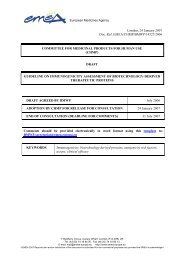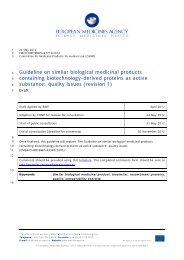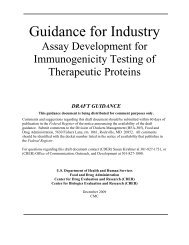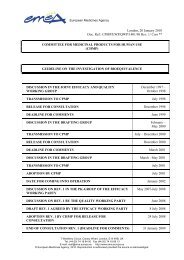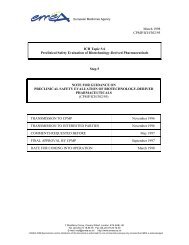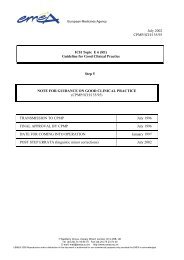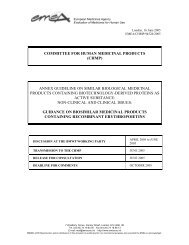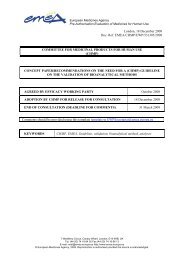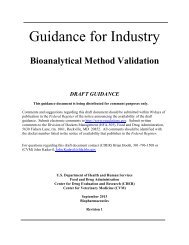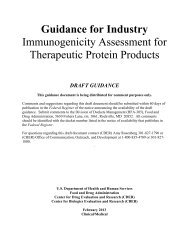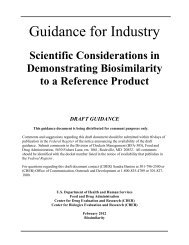Guidance for Industry - Assay Development
Assay Development for Immunogenicity Testing of Therapeutic Proteins, Draft Guidance http://www.ipm-biotech.de/fileadmin/user_upload/pdf/guidelines/FDA-GUIDANCE-Assay-Development-Immunogenicity-Testing.pdf
Assay Development for Immunogenicity Testing of Therapeutic Proteins, Draft Guidance
http://www.ipm-biotech.de/fileadmin/user_upload/pdf/guidelines/FDA-GUIDANCE-Assay-Development-Immunogenicity-Testing.pdf
You also want an ePaper? Increase the reach of your titles
YUMPU automatically turns print PDFs into web optimized ePapers that Google loves.
220<br />
221<br />
222<br />
223<br />
224<br />
225<br />
226<br />
227<br />
228<br />
229<br />
230<br />
231<br />
232<br />
233<br />
234<br />
235<br />
236<br />
237<br />
238<br />
239<br />
240<br />
241<br />
242<br />
243<br />
244<br />
245<br />
246<br />
247<br />
248<br />
249<br />
250<br />
251<br />
252<br />
253<br />
254<br />
255<br />
256<br />
257<br />
258<br />
259<br />
260<br />
261<br />
262<br />
263<br />
264<br />
265<br />
Contains Nonbinding Recommendations<br />
Draft — Not <strong>for</strong> Implementation<br />
The nature of the detection agent is also critical. Reagents, such as Protein A are not optimal as<br />
they fail to detect all immunoglobulin isotypes. Although antibody bridging studies do not<br />
depend on isotype <strong>for</strong> detection, they can present specific concerns. In these assays, antigen is<br />
used to coat a surface, antibody containing samples are allowed to react with the antigen, and<br />
binding is detected by adding a labeled <strong>for</strong>m of the antigen (product in question). Since<br />
multivalent binding of antiproduct antibody to the antigen on the plate can prevent binding of the<br />
detecting reagent, bridging assays are highly dependent on the product coating density and would<br />
be unable to detect lower affinity interactions. In these assays, the applicant should demonstrate<br />
that the labeling of the detection antigen does not significantly obscure critical antigenic<br />
determinants.<br />
• Controlling nonspecific binding<br />
Every reagent, from the plastic of the microtiter plate to developing agent, can affect assay<br />
sensitivity and non-specific binding. One of the most critical elements is the selection of the<br />
assay buffer and blocking reagents used to prevent non-specific binding to the solid surface.<br />
Since most assays require wash steps, the selection of specific detergents and concentrations is<br />
critical and should be optimized early. Similarly, the applicant should carefully consider the<br />
number of wash steps to reduce background noise, yet maintain sensitivity. A variety of proteins<br />
can be used as “blockers” in assays. However, these proteins may not all per<strong>for</strong>m equivalently in<br />
specific immunoassays. For example, they may not bind well to the microtiter plate or may<br />
show unexpected cross reactivity with the detecting reagent. There<strong>for</strong>e, the applicant may need<br />
to test several proteins to optimize results. Moreover, including uncoated wells is insufficient to<br />
control <strong>for</strong> non-specific binding. The capacity to bind to an unrelated protein may prove a better<br />
test of the binding specificity.<br />
3. Interference and Matrix<br />
Components in the matrix other than antibodies can interfere with assay results. Of greatest<br />
concern is the presence in the matrix of product or its endogenous counterpart. Specifically, if<br />
large quantities of product related material are present in sera/plasma, that material can prevent<br />
detection of antibodies in the test <strong>for</strong>mat. FDA recommends the applicant address such<br />
possibilities early (preclinical and phase 1 or early phase 2). The applicant should also examine<br />
this issue by deliberately adding known amounts of purified antibodies into assay buffer in the<br />
absence or presence of different quantities of the protein under consideration. This problem will<br />
also be minimized if the applicant collects patient samples at a time when the therapeutic protein<br />
has decayed to a level where it does not interfere with assay results. Data from pharmacokinetic<br />
studies are useful in establishing optimal sample collection times.<br />
Other serum/plasma components may also influence assay results and it is usually necessary to<br />
dilute patient samples <strong>for</strong> testing to minimize such effects. The applicant should examine the<br />
effect of such interference by recovery studies in which positive control antibodies are spiked<br />
into serum at defined concentrations. Comparing results obtained in buffer alone with those in<br />
diluted serum can provide input on the degree of interference from matrix components and guide<br />
decisions on minimum starting dilutions recommended <strong>for</strong> sample testing.<br />
C:\8495dft.doc<br />
11/4/09<br />
6




